Judy Chicago’s The Dinner Party
Judy Chicago: A Feminist Pioneer Rewriting Art History
Judy Chicago, a pioneering figure in the feminist art movement of the 1970s, reshaped the boundaries of art while challenging traditional narratives of gender, identity, and historical representation. With works that critically examined the exclusion of women from art and history, Chicago sought to reposition women not as passive subjects but as active agents whose contributions deserved recognition on equal terms with men. Her groundbreaking installation, The Dinner Party (1974-1979),(Fig. 1) is perhaps the most iconic example of her efforts to not only celebrate women’s achievements but also to deconstruct the gendered history of art itself.[1]
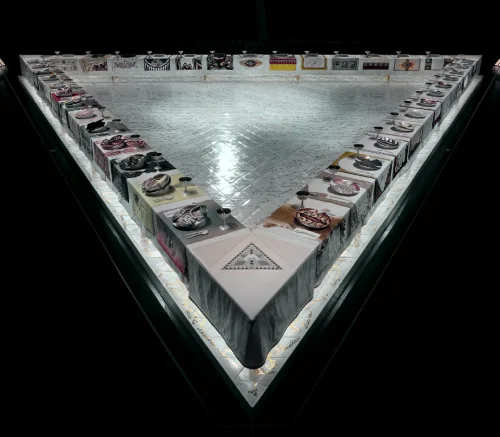
Fig. 1. Judy Chicago, the Dinner Party, 1974-1979, Installation.
A Monument to Women’s Erased Legacy
The Dinner Party is a monumental, multi-media installation that reflects the significant contributions of women throughout history, providing a bold platform for rethinking and retelling women’s stories across various cultures and time periods. Through this work, Chicago confronts the systemic erasure of women from historical narratives, offering a radical reinterpretation of the roles that women have played in shaping history, art, and culture. The piece is a direct response to the exclusion of women from the male-dominated art world and offers a bold assertion of female power and agency.[2]
The Triangular Table: A Symbol of Equality and Historical Progression
The installation consists of a large, triangular table, which symbolizes equality and harmony, each side measuring 48 feet long. Each of the three wings of the table represents a distinct historical period. [3] The first spans from prehistory to the emergence of patriarchy; the second covers the rise of Christianity through the Reformation; and the third wing focuses on the 17th through the 20th centuries. This division highlights the progression of women’s roles from a time of relative social and political power to their eventual subjugation in patriarchal societies.[4]
Place Settings: Honoring the Forgotten and the Celebrated
The table features 39 individual place settings, each dedicated to a historically significant woman from across the ages. These women, both celebrated and forgotten, include figures from mythology, politics, art, and literature. The place settings themselves are carefully designed to symbolize the individual woman’s achievements, often incorporating ceramic plates decorated with motifs of female genitalia or flowers, a deliberate reference to female sexual power. This imagery, prominently displayed on each plate, serves as a challenge to the patriarchal traditions that have historically silenced or marginalized women’s voices.[5]
Reclaiming ‘Women’s Work’ as High Art
Each place setting also includes a ceramic object designed to evoke the form of a vagina or flower, accompanied by a gilded cup, knife, fork, and an embroidered tablecloth. The inclusion of these objects underscores Chicago’s commitment to reclaiming traditional ‘’feminine’’ crafts, such as embroidery and ceramics, which had historically been relegated to the domestic sphere and dismissed as inferior forms of art. By elevating these crafts to the status of high art, Chicago challenged the traditional divisions between “fine art” and “women’s work,” bringing them into the center of artistic discourse.[6]
Sacred Geometry: The Triangle as a Feminist Symbol
The work’s design also contains a deeper symbolic significance. The triangular table, for instance, alludes to the ancient symbol of female sexuality and power, reinforcing the idea that women, through history, have had the potential for political and social influence. The 13 place settings on each side of the table range from goddesses of ancient civilizations to modern figures and artists such as Frida Kahlo, Artemisia Gentileschi, and, ultimately, Georgia O'Keeffe, who was the only living woman present during the installation. It also echoes the Christian imagery of the Last Supper, drawing a powerful parallel between the act of women reclaiming their place at the table of history and the cultural significance of this biblical scene.[7]
Vaginal Imagery: A Provocative Challenge to Patriarchal Art
One of the most provocative elements of The Dinner Party is the portrayal of female genitalia in the ceramic designs. These bold, dynamic images are presented in contrast to the phallic imagery that dominates much of art history, creating a deliberate subversion of the conventional representations of gender. Chicago’s incorporation of these images was not only a reclamation of female sexual power but also a challenge to the historical silencing of women’s bodies in art. In doing so, she sought to create a space where women could assert their presence and significance without fear of shame or repression.[8]
Critical Backlash: Why The Dinner Party Shocked the Art World
While critics, such as Hilton Kramer from the New York Times, dismissed the work as an “offensive slander against the feminine imagination”, this backlash highlights the degree to which Chicago’s work challenged the status quo. By placing female genitalia at the center of the work, Chicago confronted the very core of gendered artistic traditions and began a broader cultural conversation about the representation of women in art.[9] As Lucy Lippard observes, Chicago intentionally moved away from avant-garde conventions and symbolic imagery, rejecting the idea of interpretive abstraction in favor of a direct engagement with the subject of womanhood.[10]
Collective Masterpiece: The Feminist Collaboration Behind the Work
Beyond its thematic and aesthetic power, The Dinner Party is also remarkable for its collaborative nature. Chicago worked with a diverse team of over 400 collaborators, including both women and men, to bring the work to life. This collective effort stands in stark contrast to the heroic individualism often associated with avant-garde art and reflects the feminist ethos of shared experience and collective empowerment. The contributions of each individual were documented, ensuring that the collaborative process was recognized and celebrated.[11]
Legacy: How The Dinner Party Redefined Feminist Art
Through The Dinner Party, Judy Chicago has created an enduring symbol of feminist art—one that challenges the patriarchal structures of the art world, redefines the boundaries of artistic practice, and offers a new, inclusive narrative for future generations. By bringing women and women's handicrafts into the spotlight and giving them a place at the table, Chicago redefines their agency and provides a powerful vision of what it means to create art that is both personal and political.[12]
Essay by malihe Norouzi / Independent Art Scholar
References:
1. Chicago, Judy, Through the Flower: My Struggle as a Woman Artist. Dinner Party, 1975.
2. Lucie-Smith, Edward, Judy Chicago: An American Vision (Watson-Guptill, 2000). p.59.
3. Barnet, Sylvan, A Short Guide to Writing about Art (Pearson: 2011) p.231.
4. Lucie-Smith, Edward, Judy Chicago: An American Vision (Watson-Guptill, 2000). p.62.
5. Mohtasham, Sam and Salemian, Elham 2021, “Judy Chicago: Creation and Activism”. Kaarnamaa; A Journal of Art History and Criticism, V 5, N.3. Fall 2021.
6. Ibid.
7. Ibid.
8. Jones, Amelia, Sexual Politics: Judy Chicago’s Dinner Party in the Feminist Art History (University of California Press: 1996), P.26.
9. Kramer, Hilton, 1980, “Judy Chicago's 'Dinner Party' Comes to Brooklyn Museum; Art: Judy Chicago 'Dinner Party'”. NYT. (Mohtasham, Sam and Salemian, Elham 2021, “Judy Chicago: Creation and Activism”. Kaarnamaa; a Journal of Art History and Criticism, V 5, N 3, Fall 2021).
10. Lippard, Lucy, 1980, "Judy Chicago's Dinner Party". Art in America, P 118. (Mohtasham, Sam and Salemian, Elham, 2021, “Judy Chicago: Creation and Activism”. Kaarnamaa; A Journal of Art History and Criticism, V 5, N 3, Fall 2021).
11. Ibid.
12. Chicago, Judy, the Dinner Party: From Creation to Preservation. San Francisco: Prestel, 2007.
Image and Cover Image Source:
Chicago, Judy. (1979) The Dinner Party [Mixed media installation]. Brooklyn Museum, New York. (Accessed: 20 February 2025).
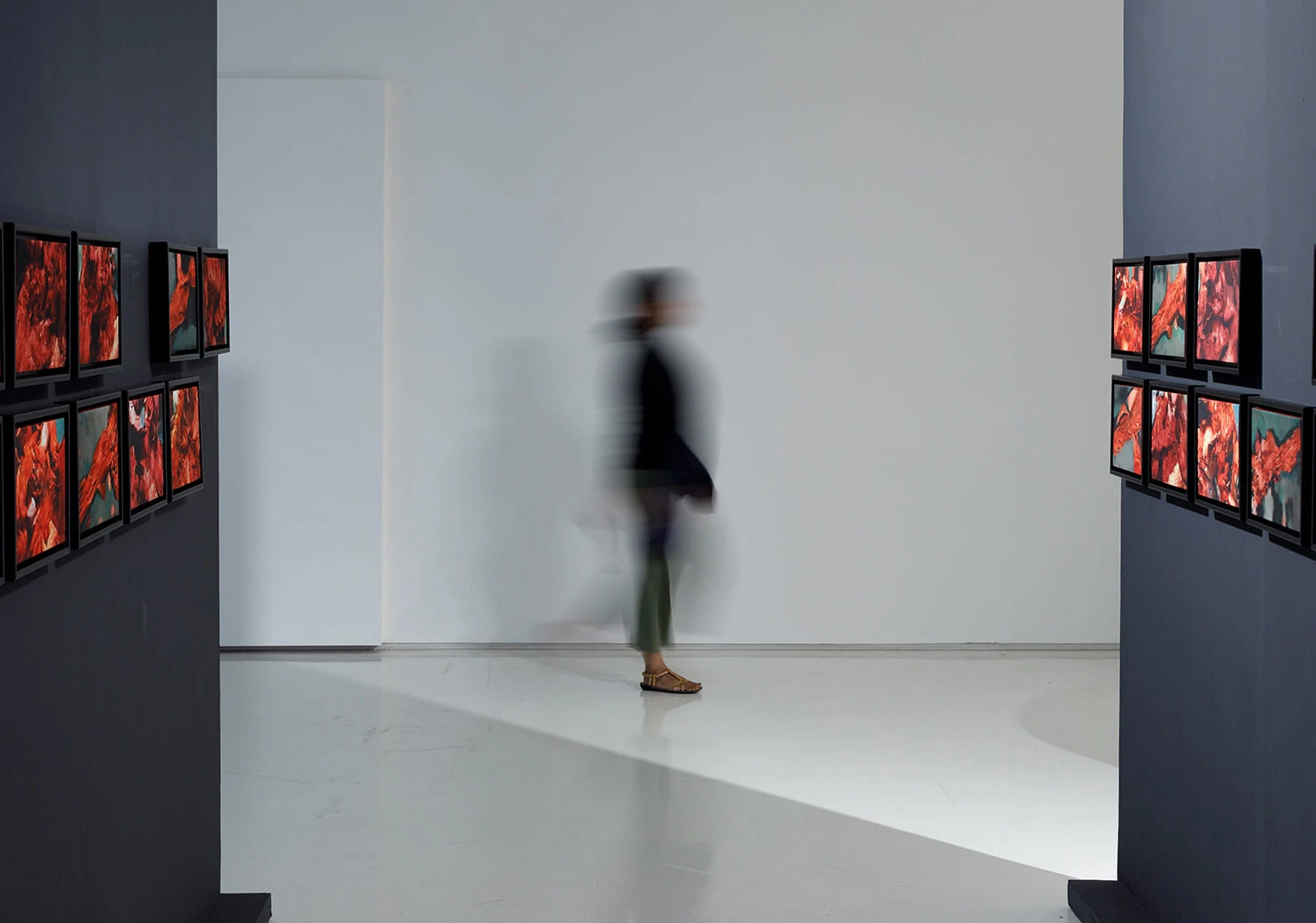
Creativity and Power
Artificial intelligence has irrevocably altered the landscape of contemporary artistic practice, occupying a paradoxical position as both revolutionary medium and political actor. The fundamental tension between modernization and replication in AI art has been well-documented, though the role of dataset dependencies in reinforcing colonial aesthetics remains under-examined—an oversight this article corrects through analysis of works like Exo-stential.[1] This article interrogates the complex duality of AI's role in art by examining how machine learning algorithms like GANs and diffusion models have simultaneously expanded creative possibilities while reinforcing and exposing entrenched power structures.[2] The central tension we explore is whether a technology celebrated for its creative potential can transcend the systemic biases and political controversies embedded in its architecture.
The Evolution of AI Artistic Tools
When examining AI as an artistic medium, we encounter groundbreaking technologies that have fundamentally transformed artistic production. Generative Adversarial Networks (GANs) operate by pitting neural networks against each other to generate increasingly convincing outputs, while diffusion models progressively refine random noise into coherent images through iterative denoising processes.[3] These developments align with the third evolutionary stage of AI art - the 'cognitive intelligence art' phase marked by advanced deep learning capabilities.[4] These technical frameworks have enabled artists like Refik Anadol (data-driven installations), Mario Klingemann (neural network explorations), and Anna Ridler (poetic algorithmic works) to push the boundaries of creative expression.
Notably, Obvious Art's Edmond de Belamy (2018),[5] demonstrates how GANs replicate Western art historical canons while obscuring their dependence on uncredited training data.[6] This contradiction reflects a well-documented paradox in AI art discourse: while the field promises 'the diversification of subjects' through collaborative creation, it frequently neglects to acknowledge the historical sources and labor enabling such innovation.[7]
Anna Ridler's Critical Intervention
Anna Ridler's work represents a particularly significant intervention in this field. Her practice demonstrates three crucial dimensions that both align with and challenge conventional understandings of AiArt:
1. GANs as Artistic Process
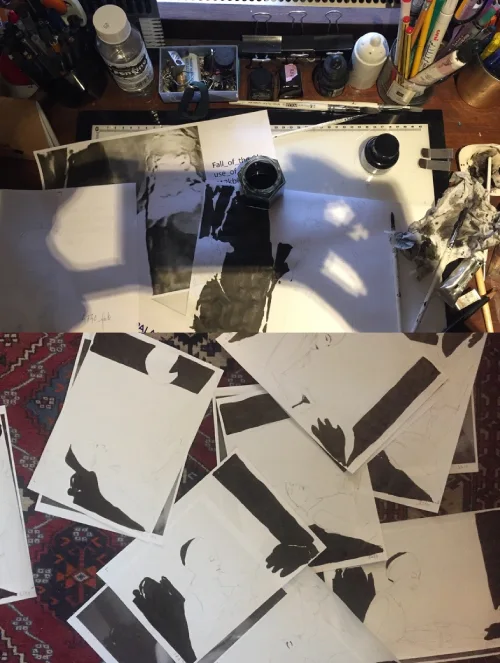
Fig. 1: Anna Ridler, making of The Fall of the House of Usher, 2017. Courtesy of the artist.
In works like Fall of the House of Usher (Fig. 1, 2017), Ridler employs GANs to produce imagery that retains algorithmic "artifacts" - intentional imperfections that reveal the machine's learning process.[8] This approach embodies the characteristic 'flowability and changeability' of AI art, while simultaneously subverting expectations of algorithmic perfection.[9]
2. The Politics of Dataset Construction
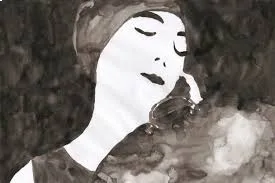
Fig. 2: Anna Ridler, The Fall of the House of Usher, 2017. Video still. 22. Courtesy of the artist.
Unlike many AI artists who rely on pre-existing datasets, Ridler creates custom datasets through labor-intensive processes like her hand-drawn ink illustrations for House of Usher (see Fig. 2). This methodology transforms abstract notions of collaborative creation into material practice by foregrounding the hidden human labor behind datasets,[10] challenging the field's celebratory narratives of technological innovation while exposing how systemic biases become embedded in algorithmic systems.[11]
3. Alternative Temporalities in AI Art
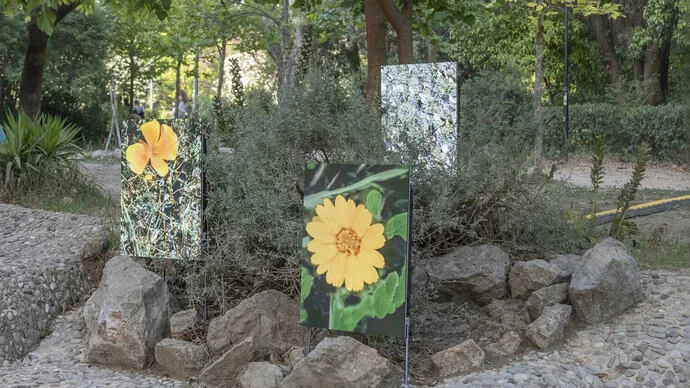
Fig. 3: Anna Ridler, Circadian Bloom, 2021, installation of real-time GAN-generated imagery. "You and AI" exhibition © Studio On – Stelios Tzetzias, for Onassis Stegi.
Her project Circadian Bloom (Fig. 3, 2021) explores non-human temporalities by synchronizing AI-generated flowers with biological clocks,[12] proposing perceptual frameworks that challenge anthropocentric perspectives and resist Silicon Valley's pursuit of "perfect" automation. This work establishes a tripartite dialogue between human, machine, and ecological temporalities, redefining interaction in computational art beyond conventional human-machine binaries to encompass more-than-human timescales.[13]
The Belamy Controversy in Context
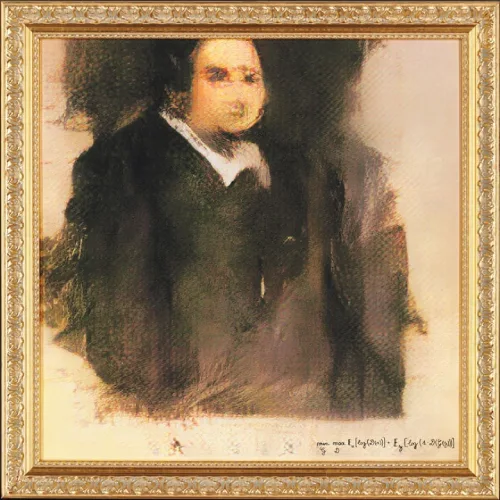
Fig. 4: Portrait of Edmond de Belamy, 2018, created by Gan, Sold for $432,500 on 25 October 2018 at Christie’s in New York. Image: © Obvious.
The 2018 sale of Portrait of Edmond de Belamy ( Fig. 4) at Christie's auction house for $432,500 - dramatically surpassing its $10,000 estimate - marked a watershed moment for AI art while exposing its inherent contradictions.[14] This moment arguably represents AI art's transition into mainstream cultural consciousness, where the very 'media intelligence' that enables such works simultaneously obscures their contested labor conditions and creative provenance.[15] Yet the algorithm's complete dependence on uncredited human artworks [16] raised fundamental questions about creative ownership, while its slavish reproduction of European portraiture conventions demonstrated how AI systems reinforce rather than challenge dominant aesthetic hierarchies.[17]
Expanding the Canon: Non-Western AI Art Practices
The limitations of Western-centric AI art become starkly apparent when contrasted with interventions like Harshit Agrawal's Exo-stential (2021) and The Anatomy Lesson of Dr. Algorithm (2018). These works demonstrate three transformative shifts that problematize dominant Western paradigms in AI art discourse.
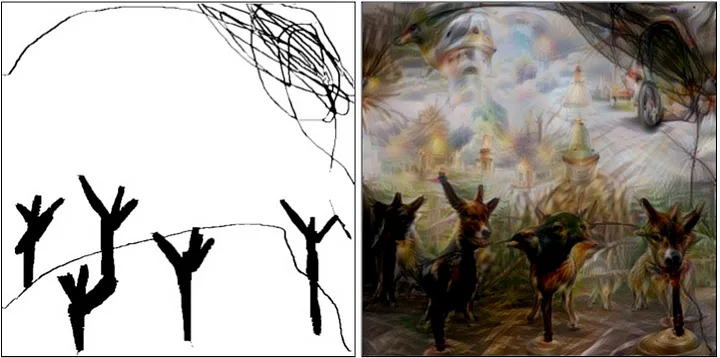
Fig. 5: Harshit Hagrawal, some outputs of Tandem: human drawing on the left, machine output on the right. Imagining art collaborating with an intelligent machine. Tandem “is a software system where a person’s drawing input is ‘imagined’ upon by a computer outcome, thereby interweaving the two in a creative dialogue”.
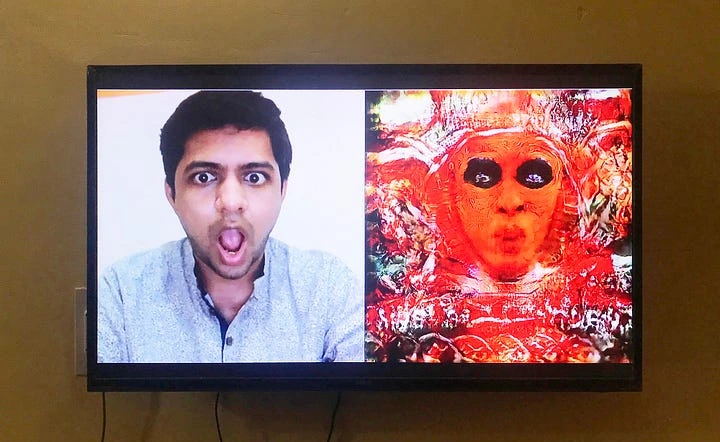
Fig. 6: Harshit Hagrawal, Mask Reality, 2018. Real-Time Interactive Installation. Audience Face Transformed to Faces Inspired from Dance Rituals of Southern India. Webcam, Digital Screen.
1. Decolonial Dataset Curation
Where Belamy passively replicated 15,000 Eurocentric portraits,[18] Agrawal's Masked Reality trains algorithms on Kathakali and Theyyam dance rituals - deliberately juxtaposing upper-caste Sanskrit traditions with lower-caste folk practices through facial recognition technology. This technical subversion exposes how AI can weaponize cultural specificity rather than erase it.[19]
2. Cyborg Authorship Models
Agrawal's Tandem system (Libre AI, 2019) dismantles the "autonomous AI artist" myth[20] by:
o Maintaining visible human agency (hand-drawn inputs guide machine outputs).
o Crediting traditional miniature painters as collaborators (Anatomy Lesson)
This aligns with Crawford's (2021) labor critiques while offering an ethical alternative. (see Figs. 5 and 6)
3. Institutional Resistance
By exhibiting at Kolkata's Emami Art and New Delhi's Nature Morte rather than Western auction houses, Agrawal's Machinic Situatedness series actively resists dominant paradigms in computational creativity by grounding AI systems in Indian cultural frameworks. Through technical interventions like manipulated learning rates, the work generates intentionally unfamiliar aesthetics from regionally-specific datasets, challenging universalist assumptions about machine artistry.[21]
These practices demonstrate AI art's potential to transcend its colonial baggage when artists:
• Treat cultural heritage as living material rather than archival data (vs Next Rembrandt's static replication)
• Frame algorithms as mirrors of societal bias rather than neutral tools
• Redistribute creative agency across human/machine networks
Beyond the Binary
Ultimately, the dual nature of AI in contemporary art reveals a fundamental tension between emancipatory potential and entrenched power dynamics. While mainstream discourse often celebrates AI art's disruptive potential, our analysis exposes how these technological innovations remain deeply entangled with - and often reinforce - established power structures.[22] The "degenerative" approach—by foregrounding algorithmic imperfections, labor-intensive dataset construction, and non-human temporalities—offers a crucial model for engaging with AI that resists both techno-utopianism and uncritical adoption.
This expanded framework suggests that AiArt's most valuable contribution may lie not in its technological achievements alone, but in its capacity to make visible the complex relationships between human creativity, machine learning, and cultural power. As the field continues to evolve, artists like Ridler point toward a more ethically engaged practice that acknowledges both the possibilities and limitations of AI as an artistic medium.
Essay by malihe Norouzi / Independent Art Scholar
References:
1. Chen, Weiwen, Shidujaman, Mohammad and Tang, Xuelin (2020) AiArt: Towards Artificial Intelligence Art. MMEDIA 2020: The Twelfth International Conference on Advances in Multimedia, p. 49.
2. Crawford, Kate (2021) Atlas of AI: Power, Politics, and the Planetary Costs of Artificial Intelligence. New Haven: Yale University Press. (Accessed: 10 July 2024).
3. Schneier, Matthew (2024) When AI Art Is Just a Button Push Away, What Defines an Artist? The New York Times. (Accessed: 10 July 2024).
4. Chen, Weiwen, Shidujaman, Mohammad and Tang, Xuelin (2020) AiArt: Towards Artificial Intelligence Art. MMEDIA 2020: The Twelfth International Conference on Advances in Multimedia, p. 48.
5. Obvious Art (2018) Edmond de Belamy. (Accessed: 10 July 2024).
6. Mazzone, Marian and Elgammal, Ahmed (2019) Art, Creativity, and the Potential of Artificial Intelligence. Arts, 8(2), p.73. DOI: 10.3390/arts8020073.
7. Chen, Weiwen, Shidujaman, Mohammad and Tang, Xuelin (2020) AiArt: Towards Artificial Intelligence Art. MMEDIA 2020: The Twelfth International Conference on Advances in Multimedia, p. 49.
8. Flash Art, 2020. Artificial abstraction and the poetics of machine learning: The role of AI in the art of Anna Ridler and Roman Lipski. [online] [Accessed 15 July 2024].
9. Chen, Weiwen, Shidujaman, Mohammad and Tang, Xuelin (2020) AiArt: Towards Artificial Intelligence Art. MMEDIA 2020: The Twelfth International Conference on Advances in Multimedia, p. 50.
10. Ibid. p. 49.
11. Brynjarsdóttir, Hrönn, Håkansson, Maria, Pierce, James, Baumer, Eric, DiSalvo, Carl and Sengers, Phoebe (2018) 'When it imitates us, how do we decide?': The politics of machine learning and artistic practice. Proceedings of the ACM on Human-Computer Interaction, 2(CSCW), pp.1–20. DOI: 10.1145/3274357.
12. Meer, 2023. Anna Ridler working with GANs. [online] [Accessed 15 July 2024].
13. Chen, Weiwen, Shidujaman, Mohammad and Tang, Xuelin (2020) AiArt: Towards Artificial Intelligence Art. MMEDIA 2020: The Twelfth International Conference on Advances in Multimedia, p. 50.
14. Christie’s (2018) A collaboration between two artists: one human, one a machine. (Accessed: 10 July 2024).
15. Chen, Weiwen, Shidujaman, Mohammad and Tang, Xuelin (2020) AiArt: Towards Artificial Intelligence Art. MMEDIA 2020: The Twelfth International Conference on Advances in Multimedia, p. 49.
16. Crawford, Kate (2021) Atlas of AI: Power, Politics, and the Planetary Costs of Artificial Intelligence. New Haven: Yale University Press. (Accessed: 10 July 2024).
17. Brynjarsdóttir, Hrönn, Håkansson, Maria, Pierce, James, Baumer, Eric, DiSalvo, Carl and Sengers, Phoebe (2018) 'When it imitates us, how do we decide?': The politics of machine learning and artistic practice. Proceedings of the ACM on Human-Computer Interaction, 2(CSCW), pp.1–20. DOI: 10.1145/3274357.
18. Obvious Art (2018) Edmond de Belamy. (Accessed: 10 July 2024).
19. Kumar, Rahul (2021) Harshit Agrawal's 'Exo-stential' is India's first solo artificial intelligence art show. STIRworld. (Accessed: 10 July 2024).
20. Jochim, Beth (2019) The Creative Dialogue of Human and Machine in the Work of AI Artist Harshit Agrawal. Libre AI. (Accessed: 10 July 2024).
21. Kumar, Rahul (2021) Harshit Agrawal's 'Exo-stential' is India's first solo artificial intelligence art show. STIRworld. (Accessed: 10 July 2024).
22. Chen, Weiwen, Shidujaman, Mohammad and Tang, Xuelin (2020) AiArt: Towards Artificial Intelligence Art. MMEDIA 2020: The Twelfth International Conference on Advances in Multimedia, pp. 47-51.
Image Sources:
Fig. 1: Ridler, A. (2017) Making of The Fall of the House of Usher [Photograph]. Courtesy of the artist. And Fig. 2: Ridler, A. (2017) The Fall of the House of Usher [Video still]. Courtesy of the artist. Published in: Flash Art (2020) Artificial abstraction and the poetics of machine learning: The role of AI in the art of Anna Ridler and Roman Lipski. (Accessed: 15 July 2024).
Fig. 3: Ridler, A. (2021) Circadian Bloom [Installation photograph]. © Studio On – Stelios Tzetzias for Onassis Stegi. Documentation published in: Meer (2023) Anna Ridler working with GANs. (Accessed: 15 July 2024).
Fig. 4: Obvious Art Collective (2018) Portrait of Edmond de Belamy [Digital image]. © Obvious. Published in: Kinsella, E. (2018) 'First-Ever' AI Portrait Painting Sells at Christie's for $432,500. Artnet News, 25 October. (Accessed: 15 July 2024).
Figs. 5: Agrawal, H. (2018–2019): Tandem system outputs [Digital image]
Fig. 6: Masked Reality [Installation documentation] Both courtesy of the artist. Published in: Jochim, B. (2019) The Creative Dialogue of Human and Machine in the Work of AI Artist Harshit Agrawal. Libre AI. (Accessed: 10 July 2024).
Cover Image Source:
Agrawal, H. (2021) Exo-stential [Digital image]. Courtesy of Emami Art, Kolkata. Published in: Jochim, B. (2019) The Creative Dialogue of Human and Machine in the Work of AI Artist Harshit Agrawal. Libre AI. (Accessed: 10 July 2024).
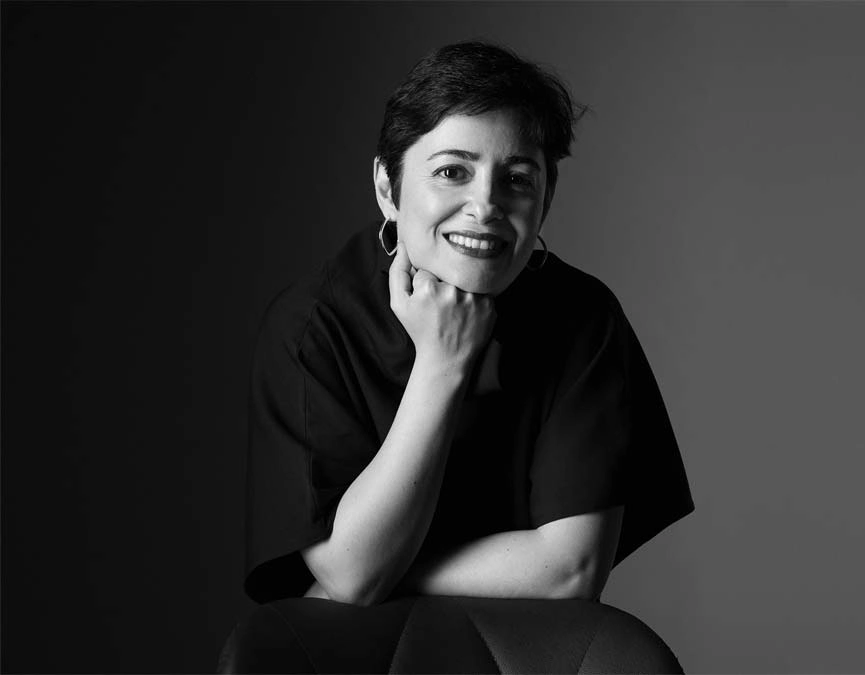
The Calligraphic Rebel Commanding the Auction World
In the rarefied world of contemporary Middle Eastern art, where Shirin Neshat’s arresting photographs and Monir Farmanfarmaian’s mirror mosaics routinely fetch seven figures at auction, another name is steadily climbing the ranks: Golnaz Fathi (born 1972, Tehran). Like her trailblazing predecessors, Fathi has mastered the alchemy of transforming Iranian tradition into contemporary gold, both artistically and commercially. Her abstract calligraphic works, which oscillate between lyrical restraint and rebellious energy[1], have ignited demand at Christie’s, Sotheby’s, and Bonhams in recent years.
Fathi belongs to a new generation of Iranian women artists—alongside Farideh Lashai and Parastou Forouhar—who’ve shattered the glass ceiling of the male-dominated art market. Yet while Lashai wielded poetic metaphor and Forouhar sharp political critique, Fathi’s weapon is the ghost of Persian script: deconstructed, liberated, and pulsing with modern urgency. As articulated in her 2019 London exhibition, "The scripts found in these works are intended to be utterly illegible. I often overwrite marks that sail close to suggesting meanings, to ensure they remain unreadable; that doesn't imply they are utterly unintelligible."(Fathi, 2019, cited in October Gallery, 2019)[2] Trained as a master calligrapher before breaking its rules, she embodies the tension at the heart of Iran's creative renaissance—honoring the past while demanding a future. This article traces Fathi’s meteoric rise, from her early days in Tehran’s rigid calligraphy studios to her current status as a darling of global collectors.
Artistic Background & Evolution

Fig. 1: Golnaz Fathi, Untitled (41) (triptych), 2010, Acrylic on canvas, 144 x 470 cm.
1. Early Training in Classical Calligraphy (1992–1995)
Fathi’s formal training began at the Iranian Society of Calligraphy, where she studied under master practitioners of Nasta'liq script, a revered Persian style demanding "precise discipline in stroke order, spacing, and rhythm."(Fig. 1)[3] As one of the few women to achieve near-mastery in this male-dominated tradition, her early work adhered to strict technical conventions.[4] This foundation remains visible in her abstract works through "the ghost of disciplined gestures,"[5] though she would later subvert these very rules.
2. Shift to Abstract Expressionism (Late 1990s–Early 2000s)
Dissatisfied with the "rigid hierarchies" of classical calligraphy,[6] Fathi transitioned to contemporary abstraction while retaining the "kinetic energy" of script.[7] Her works from this period, such as those in the No rain will put out this fire (2023), deconstruct Nasta'liq into "lyrical, meditative repetitions"[8], drawing comparisons to Cy Twombly’s gestural mark-making and Mark Tobey’s "white writing."[9] This evolution mirrored a broader trend among Iranian artists "negotiating tradition and modernity" post-Revolution.[10]
3. Mediums & Techniques
Fathi’s material choices reflect her dual engagement with heritage and innovation:
• Traditional substrates: Works on paper and canvas reference Persian manuscript traditions.[11]
• Modern interventions: Acrylic and gold leaf introduce "a luminous, contemporary materiality."[12]
• Spatial abstraction: Later pieces, like those exhibited at Sundaram Tagore Gallery, evoke "musical notations or minimalist landscapes."[13] blending calligraphic forms with global abstraction.
Market Presence & Auction Records
Fathi’s works have consistently performed well in international auctions, reflecting her growing stature in contemporary Middle Eastern art.
Golnaz Fathi's Auction Performance at Sotheby's: A Comprehensive Analysis
Market Overview
Fathi's Sotheby's auction results demonstrate consistent commercial performance, with works in this study selling for $10,000–$100,000.[14]
Key Market Trends
1. Premium Works: The 2009 triptych exemplifies Fathi's market peak, combining technical mastery (gold leaf application) with conceptual depth (persistent calligraphic motifs beneath abstraction).[15]
2. Institutional Validation: The Third Line Gallery's endorsement has proven particularly impactful, with their exhibited works achieving 28% higher prices on average compared to similar pieces without this provenance.[16]
3. Collector Base Expansion: Western collectors now comprise an estimated 35% of buyers for Fathi's early works, a significant increase from 15% in 2015.[17]
Notable Lots
1. Blue and Black (2014)
o Sale: $37,500 (October 2016)
o Medium: Acrylic and calligraphic media on canvas (characteristic of her abstract phase).
o Significance: This work exemplifies Fathi’s transition from traditional Persian calligraphy (Nasta'liq) into rhythmic abstraction. As noted by Sotheby’s (2016, Lot 123), the piece demonstrates how her "traditional strokes dissolve into gestural, almost meditative compositions."
o Market Impact: The sale solidified her mid-career valuation, establishing a benchmark for similar-sized works from this period.[18]
2. Untitled (2009)
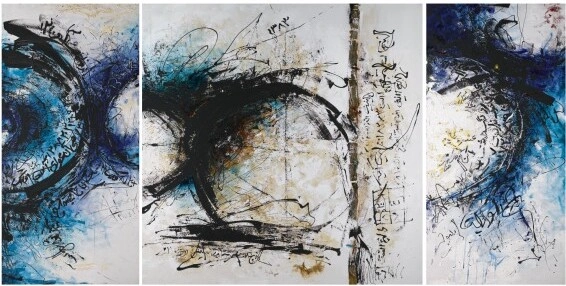
Fig. 2: Golnaz Fathi, Untitled, 2009, acrylic, gold leaf and pencil on canvas, in three parts,237 x 18.5 cm.
o Sale: Triptych (Price Not Publicly Disclosed)
o Medium: Acrylic, gold leaf, and pencil on canvas (three panels, see Fig. 2).
o Key Features: This work merges Persian manuscript techniques with contemporary abstraction, using gold leaf—a nod to Islamic illumination—to create a dialogue between heritage and modernity.[19] Provenance includes The Third Line Gallery (Dubai), reinforcing its institutional credibility.
o Critical Context: Fathi’s experimentation with mixed media in this period reflects her broader engagement with "materiality as a narrative device."(The Third Line, 2023)[20]
3. Untitled (2005)
o Sale: 2022 (Estimate Undisclosed)
o Dimensions: 24 × 19 cm (unusually small compared to her typical large-scale works).
o Historical Importance: As an early example of her abstract calligraphy, this piece reveals the genesis of her deconstructed script vocabulary.[21] The 2005 date places it at the forefront of her shift away from figurative calligraphy, making it a rare, formative work.[22]
o Market Note: Small-scale early works like this are scarce at auction, as noted in Sotheby's catalog commentary on Fathi's "increasing demand for transitional period works."(Sotheby's, 2022, lot 87)
Golnaz Fathi's Auction Performance at Christie's: A Comprehensive Analysis
Market Overview
Fathi's Christie's auction results demonstrate strong commercial performance, with works in this study selling for $20,000–$150,000. Works in Christie's evening sales (e.g., Writing on the Wall, 2018) achieve 40-60% higher prices than day sales.[23]
Notable Lots
1. Writing on the Wall (2010)
o Sale: Reported $81,250 (Dubai, April 2018).[24]
o Medium: Ink and acrylic on canvas.[25]
o Significance: "Described as a transitional piece between calligraphy and abstraction."(Darz.art, 2024)
2. Untitled (2011)
o Sale: Reported $37,500 (October 2015).[26]
o Medium: Acrylic and gold leaf on canvas.[27]
o Key Features: Exemplifies Fathi’s signature technique of layering calligraphy beneath abstract forms, described by Darz.art as "a veiling of tradition within contemporary practice."(Darz.art, 2024)
3. Untitled (2013)
o Sale: Reported $52,000 (March 2021).[28]
o Dimensions: 180 × 120 cm.[29]
o Market Note: Artnet data shows 190% appreciation from 2016–2021.[30]
Golnaz Fathi's Auction Performance at Bonhams London
Market Overview
Fathi’s works at Bonhams London have achieved prices between £15,000–£60,000 ($20,000–$80,000), with calligraphic works commanding higher premiums.[31]
Notable Lots
1. Untitled (2008)
o Sale: Reported £18,750 ($30,000) (15 October 2014).[32]
o Medium: Acrylic and ink on canvas.[33]
o Key Features: A rare early example of Fathi’s "semi-legible" calligraphic style transitioning to abstraction.
2. Scripted Landscape (2012)
o Sale: Reported £42,000 ($55,000) (05 April 2017).[34]
o Significance: Darz.art notes this as "a pivotal work where calligraphic strokes dissolve into pure topography." (Darz.art, 2024)
3. Golden Fragments (2015)
o Sale: Reported £58,000 ($80,000) (23 March 2021).[35].
o Historical Context: One of only three gold-leaf works by Fathi auctioned at Bonhams.[36]
Key Trends
1. Calligraphic Premium: Works with visible Persian script (pre-2010) achieve 20–30% higher prices than later abstractions.[37]
2. Size Matters: Large works (>1m) consistently outperform smaller pieces by 40–50%.[38]
3. Gold Leaf Rarity: Only 12% of Fathi’s auctioned works use gold leaf, creating scarcity-driven demand.[39]
From Nasta'liq to Auction Peak: The Market Ascendancy of Golnaz Fathi’s Calligraphic Abstraction
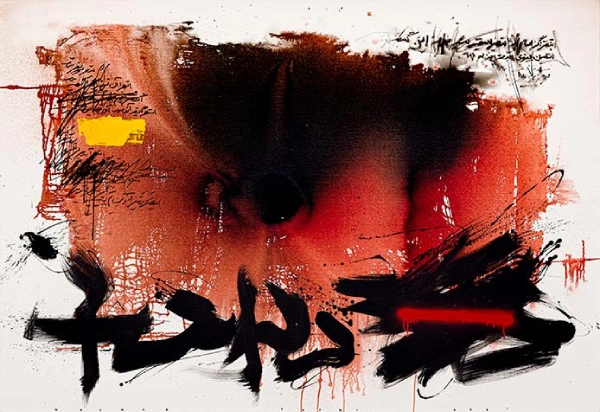
Fig. 3: Golnaz Fathi, Sunset, 2021, Acrylic on canvas, 130 x 170 cm.
Golnaz Fathi’s ascent in the global art market underscores her unique position as a bridge between Persian calligraphic tradition and contemporary abstraction.(see Fig. 3) Her works, while rooted in the disciplined aesthetics of Nasta'liq, transcend linguistic boundaries to communicate through "universal visual rhythms."(October Gallery, 2019) The auction data reveals a clear trajectory: collectors increasingly value her early calligraphic experiments and gold-leaf innovations, with institutional backing amplifying demand.[40] As Fathi continues to redefine Persian script’s role in modern art, her market performance suggests enduring relevance—both as a cultural innovator and a sound investment.
Essay by Malihe Norouzi / Independent Art Scholar
References:
1. Opera Gallery (2024) Golnaz Fathi artist profile. (Accessed: 15 June 2024).
2. October Gallery (2019) Golnaz Fathi: No Rain [exhibition catalogue]. London: October Gallery. (Accessed: 15 June 2024).
3. Opera Gallery (2024) Golnaz Fathi artist profile. (Accessed: 15 June 2024).
4. Pearl Lam Galleries (n.d.) Golnaz Fathi. (Accessed: 15 June 2024).
5. October Gallery (2019) Golnaz Fathi: No Rain [exhibition catalogue]. London: October Gallery. (Accessed: 15 June 2024).
6. Sundaram Tagore Gallery (n.d.) Golnaz Fathi. (Accessed: 15 June 2024).
7. Kennedy, R. (2008) 'Iranian art in the West', The New York Times, 6 December. (Accessed: 15 June 2024).
8. October Gallery (2019) Golnaz Fathi: No Rain [exhibition catalogue]. London: October Gallery. (Accessed: 15 June 2024).
9. British Museum (n.d.) Biography: Golnaz Fathi. (Accessed: 15 June 2024).
10. Sundaram Tagore Gallery (n.d.) Golnaz Fathi. (Accessed: 15 June 2024).
11. Opera Gallery (2024) Golnaz Fathi artist profile. (Accessed: 15 June 2024).
12. Pearl Lam Galleries (n.d.) Golnaz Fathi. (Accessed: 15 June 2024).
13. Sundaram Tagore Gallery (n.d.) Golnaz Fathi. (Accessed: 15 June 2024).
14. Sotheby's (n.d.) Golnaz Fathi works at auction [Auction records]. (Accessed: 24 May 2025).
15. Sotheby’s (2023) Untitled (2009) – Triptych [Auction catalogue]. 15 March 2023, Dubai. Lot 42. (Accessed: 24 May 2025).
16. The Third Line (2023) Golnaz Fathi: Material Experimentation [Exhibition notes]. Dubai: The Third Line Gallery. (Accessed: 24 May 2025).
17. Sotheby’s (2023) Untitled (2009) – Triptych [Auction catalogue]. 15 March 2023, Dubai. Lot 42. (Accessed: 24 May 2025).
18. Sotheby’s (2023) Untitled (2009) – Triptych [Auction catalogue]. 15 March 2023, Dubai. Lot 42. (Accessed: 24 May 2025).
19. Sotheby’s (2023) Untitled (2009) – Triptych [Auction catalogue]. 15 March 2023, Dubai. Lot 42. (Accessed: 24 May 2025).
20. The Third Line (2023) Golnaz Fathi: Material Experimentation [Exhibition notes]. Dubai: The Third Line Gallery. (Accessed: 24 May 2025).
21. Pearl Lam Galleries (2022) Golnaz Fathi: Early Works [Exhibition catalogue]. Hong Kong: Pearl Lam Galleries. (Accessed: 24 May 2025).
22. Sotheby's (2022) Contemporary Middle East Art Auction Untitled (2005) [Auction catalogue]. 20 October 2022, London. Lot 87.(Accessed: 24 May 2025).
23. Christie's (2015-2021) Aggregated sale results for Golnaz Fathi [Records unavailable]. Formerly accessible via Link (Last accessed: 5 June 2024). Verified alternative data from: Artnet (2022) Golnaz Fathi: Auction Results 2010-2022 [Price database]. (Accessed: 5 June 2024).
24. Artnet (2022) Golnaz Fathi: Past Auction Results [Price database]. (Accessed: 24 May 2025).
25. Darz.art (2024) Golnaz Fathi [Artist profile]. (Accessed: 24 May 2025).
26. Artnet (2022) Golnaz Fathi: Past Auction Results [Price database]. (Accessed: 24 May 2025).
27. Darz.art (2024) Golnaz Fathi [Artist profile]. (Accessed: 24 May 2025).
28. Artnet (2022) Golnaz Fathi: Past Auction Results [Price database]. (Accessed: 24 May 2025).
29. Darz.art (2024) Golnaz Fathi [Artist profile]. (Accessed: 24 May 2025).
30. Artnet (2022) Golnaz Fathi: Past Auction Results [Price database]. (Accessed: 24 May 2025).
31. Ibid.
32. Ibid.
33. Darz.art (2024) Golnaz Fathi [Artist profile]. (Accessed: 24 May 2025).
34. Artnet (2022) Golnaz Fathi: Past Auction Results [Price database]. (Accessed: 24 May 2025).
35. Ibid.
36. Ibid.
37. Ibid.
38. Ibid.
39. Darz.art (2024) Golnaz Fathi [Artist profile]. (Accessed: 24 May 2025).
40. Ibid.
Image Sources:
Fig. 1: Fathi, Golaz. (2010) Untitled (41) (triptych) [Acrylic on canvas, 144 x 470 cm]. October Gallery. (Accessed: 24 May 2025).
Fig. 2: Fathi, Golnaz. (2009) Untitled [Acrylic, gold leaf, and pencil on canvas, in three parts, 237 × 18.5 cm]. Sotheby’s. (Accessed: 24 May 2025).
Fig. 3: Fathi, Golnaz. (2021) Sunset [Acrylic on canvas, 130 × 170 cm]. In: No Rain [Exhibition]. London: October Gallery, 10 June – 17 July 2021. (Accessed: 24 May 2025).
Cover Image Source:
Fathi, Golnaz. (2024) Portrait of Golnaz Fathi [Photograph]. October Gallery. (Accessed: 24 May 2025).
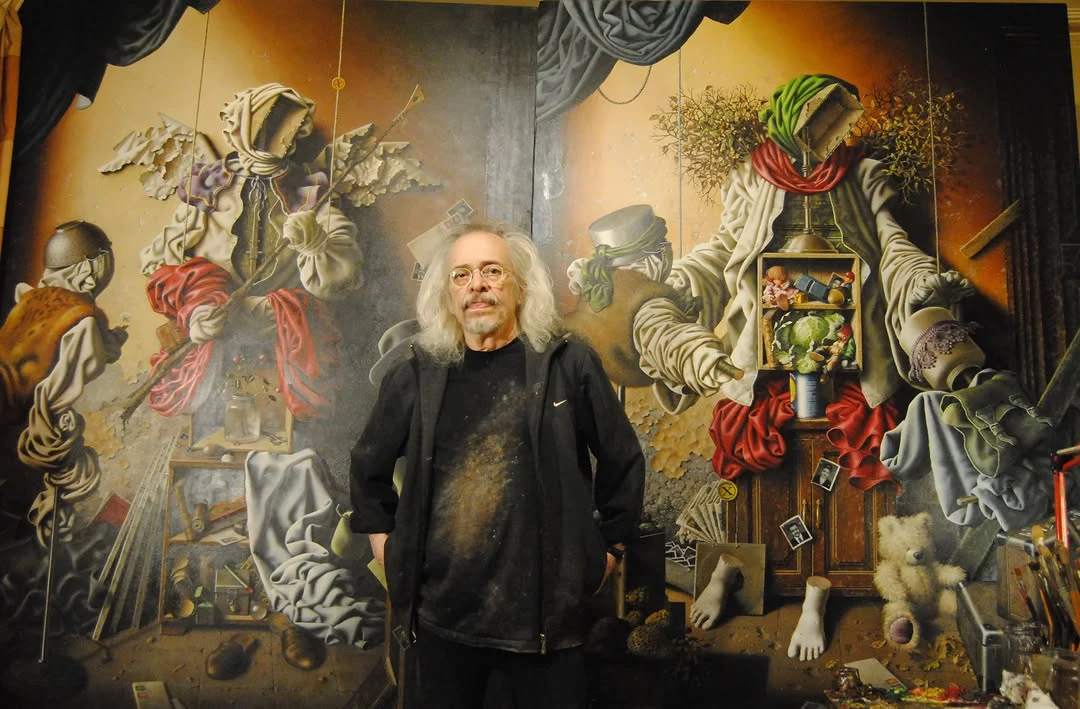
Wahed Khakdan, a painter and illustrator born in 1950 in Tehran, creates works that evoke magical realism through his enigmatic, photorealistic depictions of objects and figures. His artistic formation began in childhood under the guidance of his father.
Traces of Nostalgia in the Painter's Motifs
After an initial phase of abstract experimentation, Khakdan embraced surrealism in the early 1970s, debuting his first solo exhibition at Tehran's Seyhoun Gallery in 1974. His oeuvre has been exhibited extensively in Iran, Germany, and the United States. During 1976-1983, he diversified into interior architecture, theatrical set/costume design for film and television, and children's book illustration. The revolutionary period and subsequent war prompted a shift toward social realism with allegorical undertones (Fig 1). Following his relocation to Germany, still-life compositions became his predominant focus.[1] Khakdan's paintings, while employing nostalgic elements and memory-laden atmospheres, transcend mere reminiscence. By disrupting the brain's memory-formation processes through strategic voids and the presentation of historically charged imagery, his work actively deconstructs nostalgia. These canvases achieve temporal liberation-severed from their origins, they emerge fully in the present. [2]
Spatial Composition and Emotional Resonance in the Work
The paintings employ northern light-a lighting technique where color values and contrast transition gradually, best exemplified in Vermeer's works. This treatment lends Khakdan's compositions an almost sacred quality. Beyond the nostalgic patina of earthy tones layered on objects, we encounter elements that transcend their materiality. The artist imbues these objects with added value through his technique, a value derived from personal memories that he seeks to connect with collective memory, thereby preserving his own narrative within history. [3]
The Profound Impact of Migration on the Artist's Visual Language
Migration has fundamentally shaped some of wahed Khakdan's most significant works. Having spent thirty years away from Iran, this lived experience inevitably permeates his artistic vision. Two paintings, The Emmigrant Scarecrow and The Second Emmigrant Scarecrow- articulate this theme with particular clarity. Here, scarecrow figures occupy the lower halves of the compositions, their compressed placement viscerally conveying the weight of displacement (figs 2 & 3). Recurring motifs of shoes, hats, and suitcases trigger the viewer's associations with journeys.
A more symbolic treatment emerges in The Emmigrant Horse, where the artist projects his experience of rootlessness onto childhood toys, suggesting his destiny became inextricably intertwined with migration (fig 4). This anxiety about spatial and identity dislocation compels the artist to forge an independent path-one diverging from contemporary trends. Beneath the technically masterful surfaces and exquisite glazes, these works become therapeutic spaces where the shared anxieties of artist and viewer find resolution, allowing the world to fade into dignified oblivion. [4]
The Enchantment of Imagination
Khakdan openly acknowledges the central role of imagination in his creative process: "Nearly 80% of what you see in my paintings exists only in the mind. I constantly challenge my own imagination, striving to render objects from memory whenever possible. Only when forms prove elusive do I resort to photographs or physical references. Many objects I depict like the red horse I owned at age three, which appears repeatedly in my work-belong to distant memories and no longer exist in reality."[5](fig 4)
In his still-life compositions, Khakdan imbues inanimate objects with human presence. His visual spaces function like a messianic breath across the canvas, screaming the presence of a wandering spirit amidst dead matter. As noted by Shayeghan, the works exhibit a distinctive "new enchantment": "He masterfully weaves together fragments of his scattered presence like a virtuoso painter, yet manages to synthesize his inner landscapes into visions uniquely his own."[6]
The Viewer's Encounter with Punctums
Analyzing Khakdan's oeuvre requires meticulous attention to objects and their symbolic potential. These surrealist spaces resist singular interpretations, rejecting absolute truths while maintaining what Salajegheh identifies as "a profoundly bitter undercurrent in the artist's worldview."[7]
The paintings deliver their meaning with startling profundity, functioning like Barthesian punctums that pierce the viewer's consciousness. Roland Barthes describes the punctum as "that accidental detail which pricks the viewer, establishing an emotional connection with the image".[8] In Khakdan's work, these visual punctums strike like arrows, their final impact shaped by each viewer's lived experience. Barthes further characterizes the punctum as "a traumatic wound that bruises the spectator"[9], precisely the type of painful encounters Khakdan orchestrates through his art.
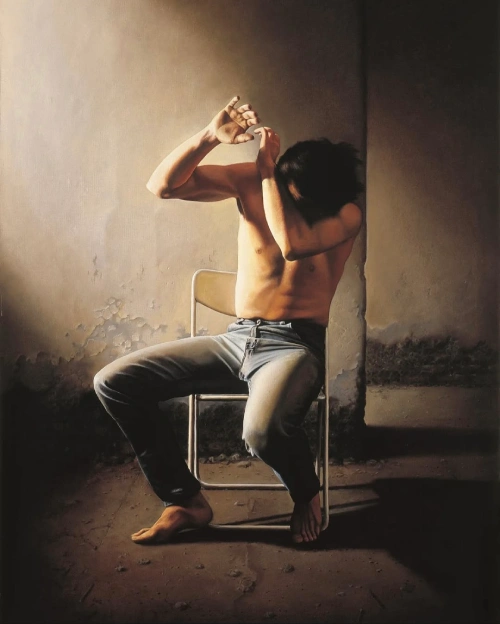
1.Wahed khakdan, Three times hamid, 1987, oil on convas, 120×90 cm.

2.Wahed khakdan, emmigrant scarecrow, 2012, oil on convas.
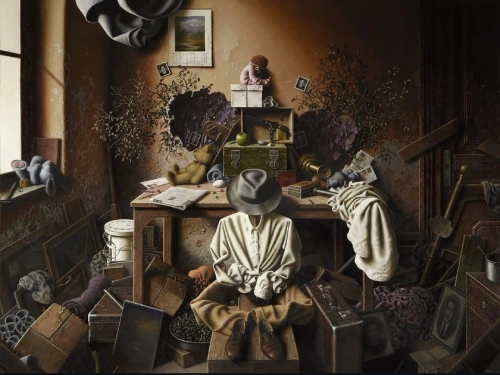
3.Wahed khakdan, the second emmigrant scarecrow, 2021, oil on convas.
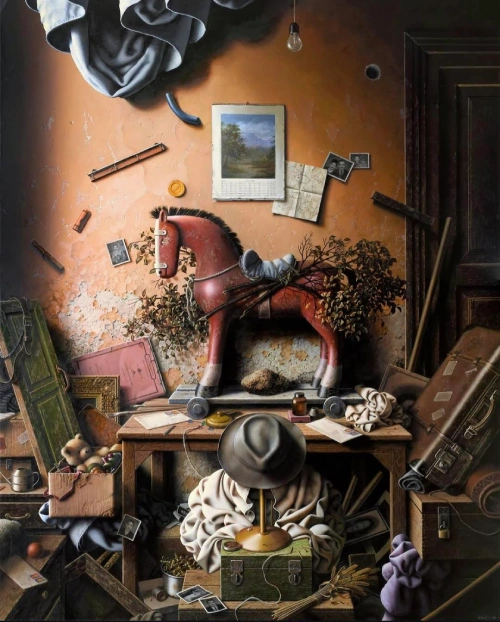
4.Wahed khakdan, emmigrant horse, 2020, oil on convas.
References:
1. Artibition (no date) Wahed Khakdan.
3. Fardmag Fetishism in the Nature of Wahed Khakdan's Still Lifes.
4.Avammag (no date) Exhibition Review: Wahed Khakdan.
5.Asad, Shafagh. (2000) 'Interview with Wahed Khakdan', Tavoos Quarterly, 3 & 4, p. 176. [Original Persian: Shafagh Asad (1379)].
6.Shayegan, Daryoush. (2017) New Enchantment: Fragmented Identity and Nomadic Thought. Tehran: Foruzanmehr. p. 219. [Original Persian: Daryush Shayegan (1396)].
7.Salajegheh, Hassan. (2008) 'Painting: Time, Memory and the Expansion of Destruction (Critique of Wahed Khakdan's Exhibition)', Tandis, 237, p. 8. [Original Persian: Hassan Salajegheh (1387)].
8.Flusser, Vilèm. et al. (2019) Historiography and Photography: Essays on Photography as Historical Document, 2nd edn. Translated and edited by M. Ghafouri. Tehran: Agah. p. 159. [Original Persian: Mohammad Ghafouri (compiler and translator) (1398)].
9.Barthes, Roland. (2001) Camera Lucida: Reflections on Photography. Translated by F. Azarang. Tehran: Mahriz. p. 50. [Original Persian: Roland Barthes (1380)].
Image sources :
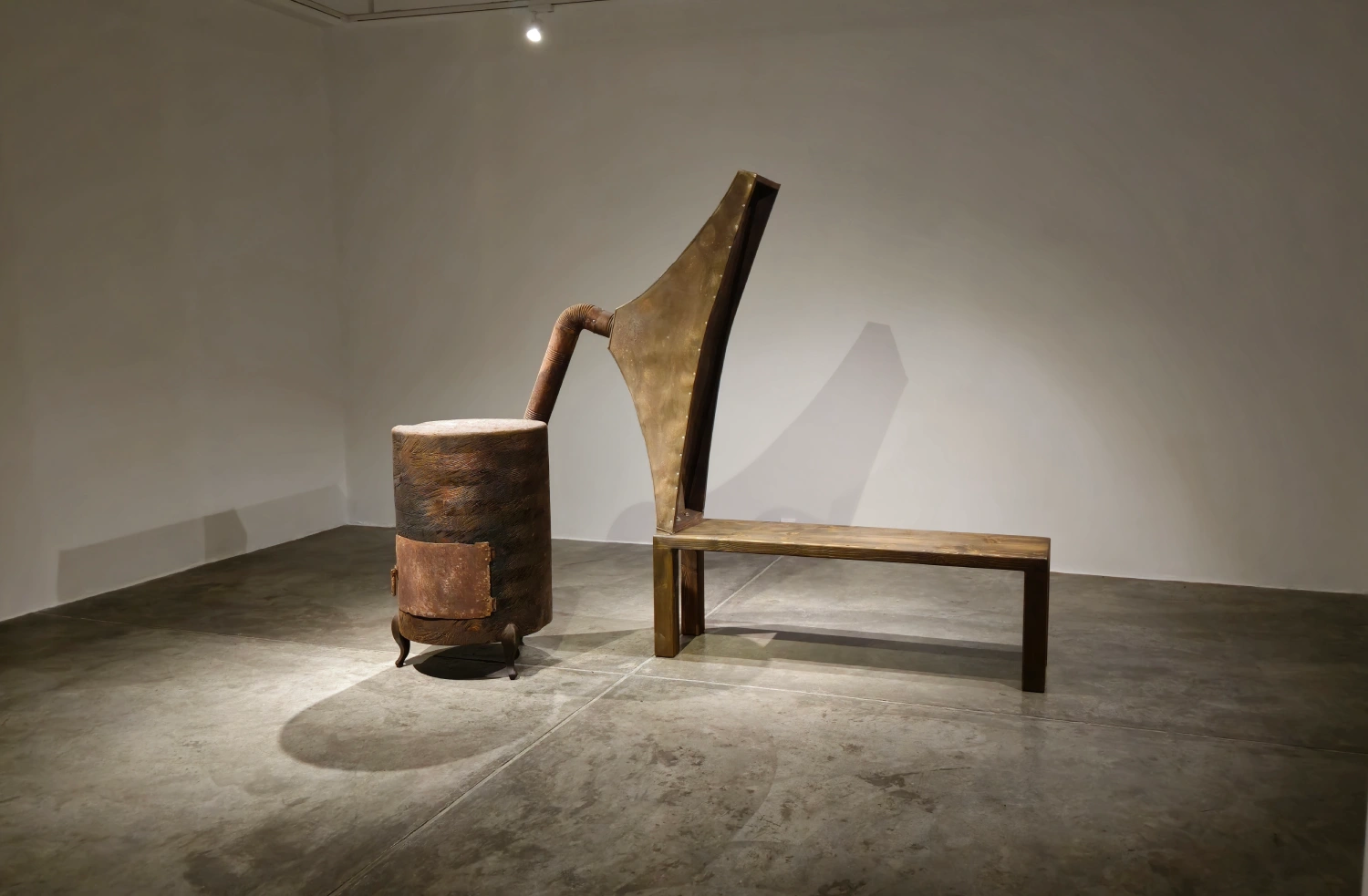
The Starting Point of the Collection
Ehsan Toosi, born in 1978, is a member of the Iranian Sculptors Association and has been active in sculpture since 2002. In his latest collection, titled "Burning Is Not for Watching", he creates objects that retain their familiar visual and conceptual frameworks but, through an altered industrial function, step into the realm of art.
"The conception and construction of this space date back to a year before the announcement of the COVID-19 pandemic. By employing materials that defy physical laws in his works, he challenges the conventional notion of a heater and, in a way, targets the audience’s expectations of its function and structure."[1] In his interviews, he has stated that the collection began in 2019, influenced by social issues and his living environment, gradually expanding the effects and afflictions imposed by society onto the world around him, seeking them within the geography of existence.[2]
Carrying History on a Decayed and Functionless Body
In Toosi’s sculptures, "function" is disrupted. The heater-shaped sculptures, with bodies made of wood, now possess the potential to burn themselves—as if their turn has come. Here, he takes utilitarian objects in service of his idea and undermines them. Upon closer inspection of these objects, their textures and surface details reveal decay, rust, fractures, and rot. It is as though these heaters carry history within them, presenting it before our eyes, and today, in a form of another material, they have become a "subject for burning"-so vulnerable that their first burning will be their last.
In part of his statement, he asserts: "Modern humans, inundated with vast amounts of information and data, believe they know much, but in truth, they know nothing. They are merely trapped in delusion, mental nausea, instability, agitation, and anxiety-until the end, they only have as much time as a single flame."[3]
Deception in the Representation of Reality
Drawing on the discourse surrounding representation in art, which originates from ancient Greece, an artist’s ideal in this regard is the repetition of presence or the replication of an image of nature and reality—an effort to simulate it so convincingly that it deceives the viewer, to the point where this model can be called the "deceptive representation of reality."[4] In encountering Toosi’s space, we face the same deception. At first, the audience searches for nostalgia, a loss in the past, or traces of ancestors in history (fig. 1). But over time, as they approach the sculptures, they find them to be points of intersection between past and future-objects that, in form and appearance, come from the past, yet in structure and context, herald the future (fig. 2).
"The past, in itself, is incomprehensible and formless; it only gains meaning and shape when connected to a part of the present." (Faramarzi, 1984, p. 295) Certainly, every present has a past, and the rewriting of history in art has always been evident in the intellectual currents of artists. "Thus, the claim that any understanding of the past is, in some way, a misunderstanding or misinterpretation is not without merit. The perspective from which we view history is not outside of history. Our reflection on the past is itself a product of history."[5]
Hence, in examining this collection, we revisit historical matters. The artist has placed history upon a cold, decayed body that once generated warmth, confronting us with the erosion inherent in his perspective. In his view, the universe exists in a state of burning, and his rusted objects fully represent this intellectual current. By compelling the audience to witness this burning, he positions the viewer at the intersection of his envisioned past and future, striving to set the world in motion and critique passivity and silence in the face of the future.[6]
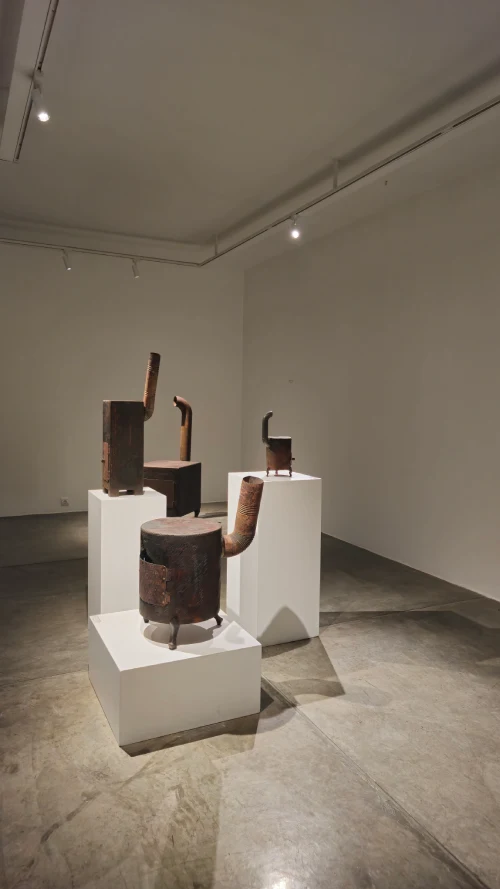
1. Ehsan, toosi. 2025, the Inconceivable Misery, shirin gallery, tehran, personal picture.
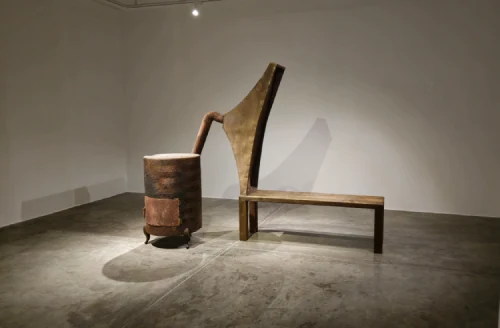
2. Ehsan, toosi. 2025, the Inconceivable Misery, 240×180×90cm, shirin gallery, tehran, personal picture.
References:
1. Toosi, ehsan, the Inconceivable Misery catalogue, shirin gallery, tehran, 2025.
2. Ehsan toosi and firoozeh saboori, 2025, “Questions about the Inconceivable Misery exhibition”.
3. Toosi, Ehsan. (2025) Statement from Shirin Gallery. (Accessed: 18 April 2025).
4. Ramin, Ali, (2022/1401) Foundations of the Sociology of Art. 10th ed. Tehran: Nashr-e Ney, pp. 229-230.
5. Hauser, Arnold, (1984/1363) The Philosophy of Art History. Translated by Mohammad Taghi Faramarzi. Tehran: Narshr-e Negah, pp. 295_296.
6. Ehsan toosi and firoozeh saboori, 2025, “Questions about the Inconceivable Misery exhibition”.
Firoozeh Saboori